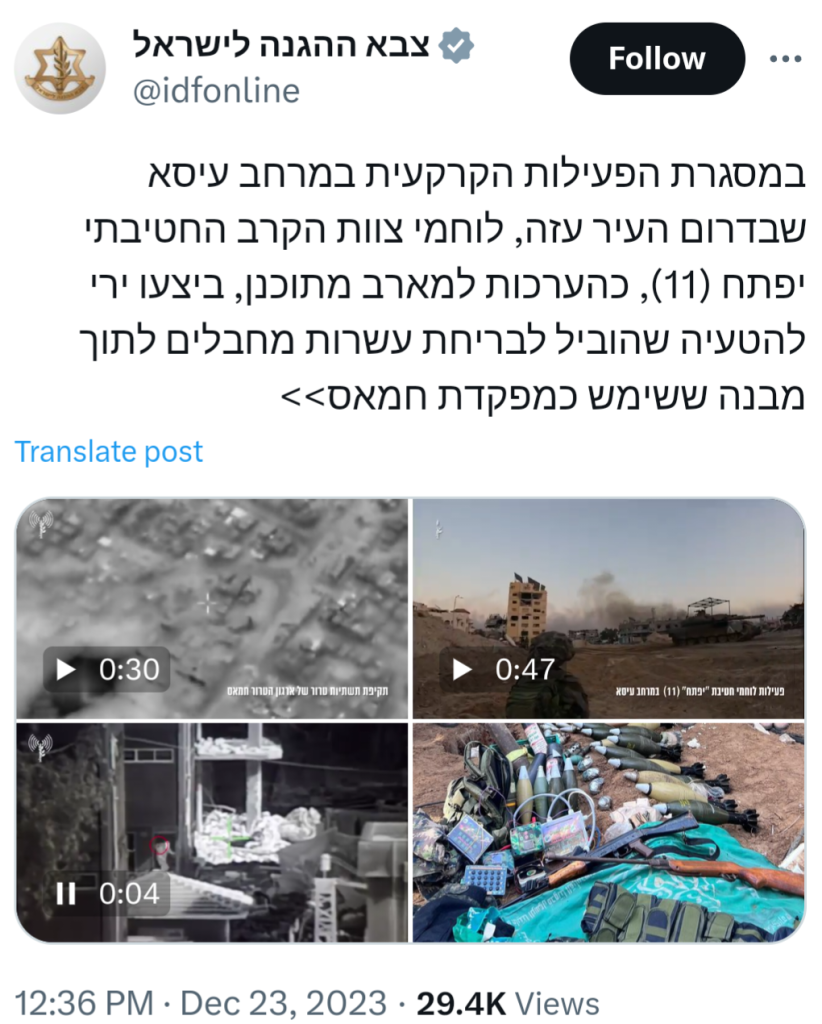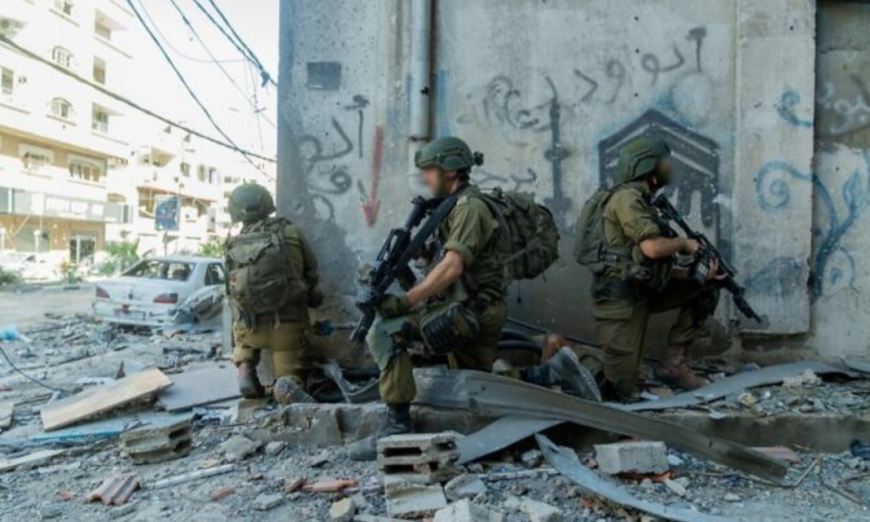IDF troops seen operating in the Gaza Strip in this handout photo released December 23, 2023. (Israel Defense Forces.)
Army says it intentionally caused dozens of gunmen to flee into building used as command center, then called in an airstrike; rockets target south for first time in nearly 48 hours.
The Israel Defense Forces gave details Saturday on its ongoing war against Hamas in the Gaza Strip, detailing gun battles and strikes on terror operatives as well as arrests.
Hamas, too, reported heavy shelling in several cities in the territory, hours after world powers in a UN Security Council vote demanded more aid be allowed into the Palestinian territory.
During ground operations in the southern part of Gaza City, the IDF said troops of the Yiftah Reserve Brigade carried out an ambush against Hamas, leading to dozens of terror operatives being killed.
The IDF said the troops opened fire in a deceptive manner to cause dozens of gunmen to flee into a building used as a command center. The building was then struck by a fighter jet.
Also in the southern Gaza City area, the IDF said Yiftah Brigade snipers killed several Hamas gunmen who were preparing to attack troops. Other buildings identified by the brigade as being used by Hamas in the area were struck by aircraft, the IDF added.
In an unspecified area of Gaza City, the IDF said troops of the 14th Reserve Armored Brigade identified a group of Hamas gunmen and called in an airstrike. In the Shati camp area of Gaza City, it said the 14th Brigade identified a further three Hamas gunmen who had opened fire at them. The brigade called in an airstrike to kill the three operatives.
The incidents in Gaza City indicate that while the IDF has operational control over the area, it is still battling smaller Hamas cells.
Meanwhile, in central Gaza, the army said the 179th Reserve Armored Brigade found a cache of weapons in a children’s daycare center, including mortars, RPGs and other explosives.

Clouds of gray and black smoke rose over the southern Gaza city of Khan Younis after strikes in the morning.
The Hamas-controlled health ministry reported that 18 people had been killed in a strike on a house in Nuseirat camp in central Gaza, and said other targets were hit up and down the coastal Strip.
Also Saturday, the IDF and Shin Bet said more than 200 Hamas and Palestinian Islamic Jihad terror operatives had been captured in the Gaza Strip over the past week, and taken for questioning.
The joint statement said hundreds of suspects were detained in the Strip over the past week, of which more than 200 were brought to Israel to be interrogated by the Shin Bet and Military Intelligence Directorate’s Unit 504.
It said some of the captured Hamas and Islamic Jihad operatives were hiding within the civilian population before surrendering to troops.
So far since the beginning of the ground offensive, more than 700 terror operatives have been captured and brought to Israel, the IDF said.
Early Saturday afternoon, rockets were launched from the Gaza Strip at southern Israel after a lull of nearly 48 hours.
The attack set off sirens in the largely evacuated border community of Kfar Aza. There were no reports of injuries or damage. Locals reported seeing four interceptor missiles downing the incoming projectiles.
The rate of rocket fire from Gaza has slowed significantly in recent weeks, as the IDF expands its ground offensive against Hamas.
Friday saw the United Nations Security Council vote to pass a resolution that called to immediately speed up the delivery of humanitarian aid into Gaza while also “creating the conditions” for an end to the Israel-Hamas war.
The resolution “calls for urgent steps to immediately allow safe, unhindered and expanded humanitarian access and to create the conditions for a sustainable cessation of hostilities.”
It was the first time since the war began with Hamas’s October 7 attack on Israel that the council has passed a resolution including language regarding a “cessation of hostilities,” but it still stopped short of demanding an immediate and permanent ceasefire, which both the US and Israel oppose.
The resolution reaffirmed the one approved last month, which called for temporary pauses in the fighting, and it again demanded the release of all hostages held by Hamas and other terror groups in Gaza.
The resolution introduced by the United Arab Emirates was adopted with 13 votes in favor and zero against. Rivals US and Russia abstained, with the former explaining that the draft failed to condemn Hamas, while the latter argued that it failed to call for an immediate ceasefire.
Russian Ambassador to the UN Vasily Nebenzya sought to have an amendment added at the last minute that called for “an urgent and sustainable cessation of hostilities,” dropping the phrase about “creating conditions” toward that end. This was the language used in the original draft of the resolution submitted on Monday.
The US opposed the language then, and US Ambassador to the UN Linda Thomas-Greenfield exercised her veto power to block it from passing on Friday. Friday’s vote came after days of intense negotiations and delays required to get the US on board with the motion that eventually passed.
The Palestinian Authority’s representative to the UN called the Security Council resolution “a step in the right direction,” but reiterated calls for an immediate ceasefire.
“It must be implemented and must be accompanied by massive pressure for an immediate ceasefire. I repeat, immediate ceasefire,” said Riyad Mansour.
Friday saw the IDF begin to call on some residents of central Gaza to evacuate south in the latest indication that the military’s ground offensive in the Strip was expanding, as the defense minister issued a renewed threat against Hamas chief Yahya Sinwar and the military revealed a new major Hamas tunnel network.
Lt. Col. Avichay Adraee, the IDF’s Arabic-language spokesman, published a map of the zones in central Gaza’s Bureij town whose residents the army was urging to head for shelters in Deir al-Balah.
Adraee also said that Gaza’s main north-south highway, Salah ad-Din, in the areas northeast of Khan Younis, still remains a “battle zone” and that the IDF will instead facilitate the movement of civilians via a bypass route along the coast.
Additionally, Adraee said in his statement the IDF will make “tactical pauses in military activities” in the western neighborhoods of Rafah in southern Gaza, between 10 a.m. and 2 p.m., for “humanitarian purposes.”
Meanwhile, Defense Minister Yoav Gallant issued a renewed threat Friday evening against Sinwar, saying the Hamas leader in Gaza will soon “meet the barrels of our guns.”
Gallant said the IDF was “gradually completing” its goals in northern Gaza, while also operating in the Khan Younis area and southern Gaza, and will operate in other places in the future, he said.
The IDF revealed later Friday that it had uncovered another large Hamas tunnel network in the southern part of Gaza City, publishing footage showing a dog from the Oketz canine unit scanning the underground passages.
According to the IDF, the network is hundreds of meters long and includes command rooms, storage and large resting areas with electricity, communication lines and water.
The tunnel was found by the IDF after troops of the Yiftah Brigade and combat engineers battled Hamas operatives at a main compound belonging to the terror group in Gaza City, near the al-Quds Hospital.
The tunnels were later destroyed by combat engineers and the 99th Division.
IDF spokesman Daniel Hagari said Friday that the military is nearing complete “operational control” of northern Gaza, as it further expands operations in the southern part of the Strip.
He said at a press conference that troops were battling the last standing Hamas battalion, in the Daraj and Tuffah neighborhoods of Gaza City, and still fighting Hamas in other areas of northern Gaza, albeit at a “lower intensity.”
Later Saturday, the IDF announced the deaths of five soldiers killed during fighting in the Gaza Strip over the weekend, bringing the toll of slain troops in the ground offensive against Hamas to 144.
They were named as Staff Sgt. Nir Rafael Kananian, 20, of the Givati Brigade’s reconnaissance unit, from Beit Keshet; Staff Sgt. Birhanu Kassie, 20, of the Givati Brigade’s reconnaissance unit, from Beit Shemesh; Master Sgt. (res.) Shay Termin, 26, of the 55th Reserve Paratroopers Brigade’s 6623rd Battalion, from Rosh Pina; Warrant Officer (res.) Alexander Shpits, 41, of the 55th Reserve Paratroopers Brigade’s 6623rd Battalion, from Karmiel and Cpt. Oshri Moshe Butzhak, 22, a team commander in the Nahal Brigade’s reconnaissance unit, from Haifa.
Kananian, Kassie, Termin, and Shpits were killed on Friday in southern Gaza, while Butzhak was killed Saturday in the Strip’s north.
Another five soldiers of the Givati Brigade’s reconnaissance unit were seriously wounded in the battle in which Kananian and Kassie were killed, the IDF added
The announcement came a day after two fallen soldiers were named Friday as Sgt. First Class (res.) Tal Shua, 31, of the Combat Engineering Corps’ 7071st Battalion, from Beersheba; and Lt. Shai Ayeli, 21, a cadet in the Bahad 1 officers’ school’s Gefen Battalion, who previously served in the Air Force’s Unit 669, from Ashkelon.
The military also said Friday that a reservist and two other soldiers were seriously injured in battles in northern and southern Gaza.
Adraee’s announcement about evacuations came a day after the IDF said it had expanded its ground operation in the central Gaza Strip to new areas.
According to the IDF, its 99th Division maneuvered into new areas of central Gaza to establish “operational control” south of Gaza City and north of the so-called central camps of central Gaza.
The IDF also announced Thursday that it had established full “operational control” over Gaza City’s Shejaiya neighborhood, which saw some of the fiercest fighting during the ground offensive against Hamas and had dismantled Hamas’s “core capabilities” in the area.
It said dozens of tunnel shafts, found in homes, schools and health clinics, were destroyed along with caches of weapons. The IDF said soldiers in its Golani Brigade raided the homes of senior Hamas members and seized intelligence materials in Shejaiya, and the 188th Armored Brigade captured the headquarters of Hamas’s Shejaiya battalion, from which terrorists set out to carry out the October 7 onslaught in southern Israel.
The Paratroopers Brigade, meanwhile, demolished more than 100 buildings used by Hamas in the area, as well as located dozens of tunnel shafts, and arrested many operatives who had surrendered, among them a Hamas company commander and terrorists who participated in the October 7 massacres, the IDF said.
Palestinian terrorists also fired dozens of rockets at southern and central Israel on Thursday, putting a violent end to a period of nearly two days in which no projectiles were shot at the country from Gaza.
The salvo on central Israel Thursday punctured the hope that the military’s offensive has damaged Gazan terrorists’ ability to fire rockets. The IDF has still been warning civilians to follow the Home Front Command’s emergency instructions, even as rocket fire from Gaza has slowed significantly.
Israel launched its vast military operation against Hamas following the terror group’s murderous invasion of southern Israel on October 7, in which it killed around 1,200 people, mostly civilians, and took another 240 hostages into Gaza. The Hamas-run Gaza health ministry claims more than 20,000 people have been killed in the Strip during the war, an unverified figure. Israel says it assesses troops have killed some 8,000 terror operatives. Another 1,000 Hamas terrorists were killed in Israel on October 7, during the terror group’s onslaught.

